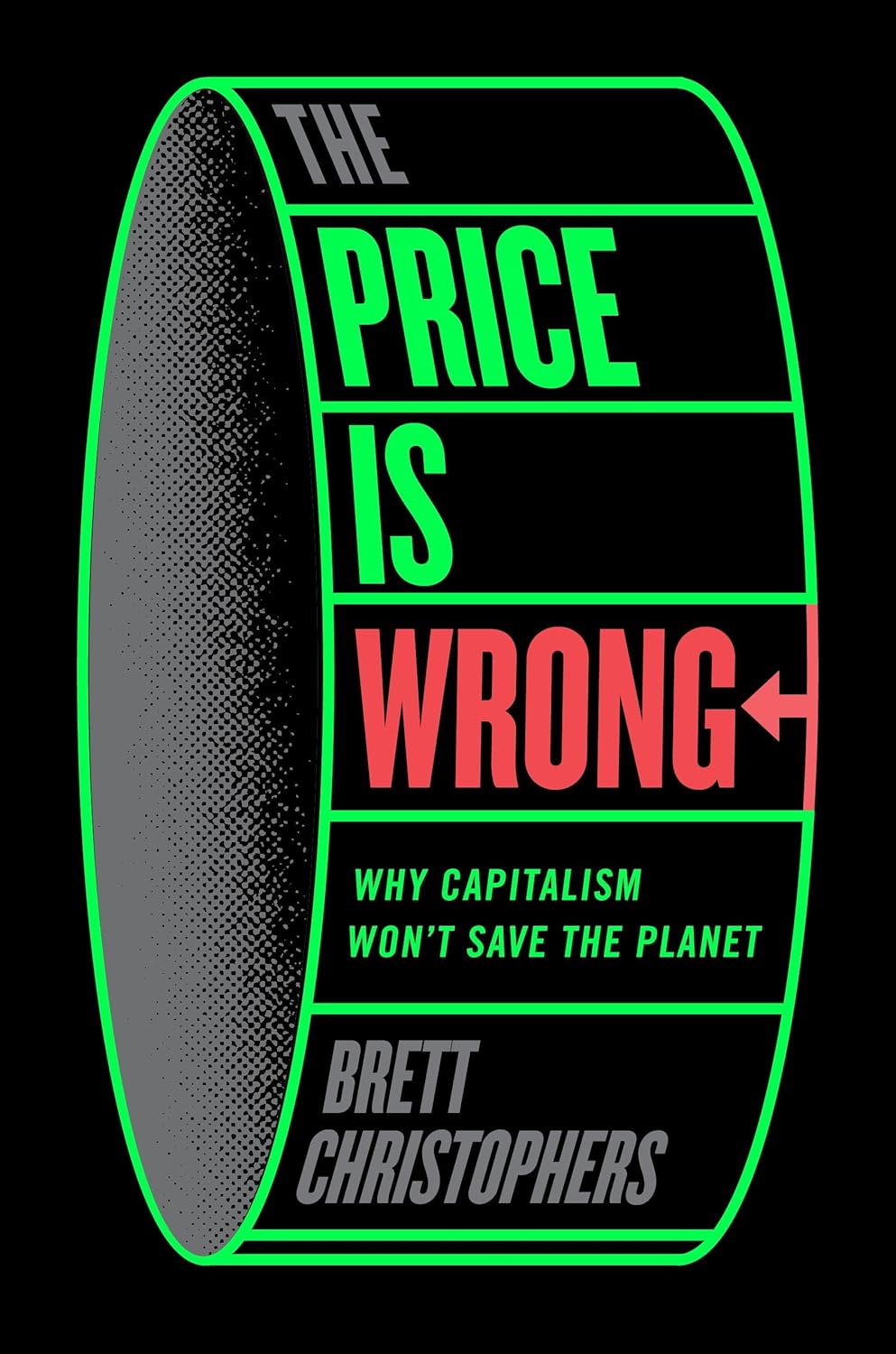
Brett Christophers
The Price Is Wrong: Why Capitalism Won’t Save the Planet
Verso Books, 2024
432 pages
$19.95
Reviewed by Nathaniel Wachtel
The Price is Wrong offers a thorough answer to one simple question: if solar and wind energies are unprecedentedly cheaper than fossil fuel energies, why aren’t these technologies dominating the energy investment market? Brett Christophers points to a widespread misunderstanding of energy investment dynamics, one that conflates price with profit. He argues against the free market fundamentalist viewpoint that the shifting price dynamics between renewables and fossil fuels ensure decarbonization, painting a much more complicated picture of energy markets. His book debunks this misunderstanding, leading the reader through a narrative of global electricity markets and the policies that shape them. The introduction acknowledges that while renewable energy investment still faces roadblocks like permitting and fossil fuel interests, the economics of renewable investment remain an issue despite proclamations otherwise. The book does not address these other roadblocks but focuses instead on the economics of energy development, with particular attention to the financial and state actors that renewable energy developers rely on. Though readers with a background in energy or economics will have an advantage in understanding his language, Christophers is careful to explain economic and energy industry jargon in depth, building on the reader’s energy vocabulary with each chapter.
Chapter One details the stakes of electricity decarbonization. Electricity is the number one source of global carbon emissions, and as demand worldwide is projected to double or triple by 2050, clean energy is a core component of any net-zero plan. The feasibility of such a plan depends on the suitability of renewable energy alternatives for worldwide development. Christophers examines these alternatives through a costs and benefits analysis covering problems of scale, speed and scope. He concludes that worldwide renewable investment is focused primarily on solar and wind due to their relative quickness of power plant construction. In Chapter Two, Christophers details the transformation of US energy markets from a vertically integrated model in which publicly owned companies sell energy on a cost basis to one marked by institutional specialization, private ownership, and market competition. This chapter also details the development of capacity markets where generators do not sell their electricity, but rather sign a contract “to be available in the future to generate electricity.” Chapter Three considers the financing of prospective renewable projects through a typical 75/25 ratio of debt-to-equity. As it is difficult to guarantee finance firms the requisite profit to secure equity, many projects never come to fruition. Tax credits can help convince the firms to provide such equity, since in the absence of subsidy, projects are often unable to secure the necessary financing.
Chapter Four presents ‘the price is right’ as a consumerist parable—the most important measure of economic value in the Western cultural consciousness. Christophers then debunks the fetishization of Levelized Cost of Energy (LCOE) measurements by renewable proponents, showing how belief in this consumerist parable is evident in the manner in which economists and politicians regard LCOE values. These values ignore issues like temporality, distance, connectivity and land costs. This oversight leads to a disregard of a slew of problems including relative frontloading of costs, increased land intensity, conventional fossil fuel grid infrastructure and transmission line costs. Chapter Five delves deeper into these issues, focusing especially on the distribution of costs over time. LCOE does not acknowledge the sunk costs inherent in utility grids worldwide, grids built for gas and coal fired plants. Chapter Six discusses the stacking of generator bids in the UK spot market, a model which is proving increasingly popular internationally. In this model generators of all different energy varieties place bids to sell their power and all suppliers are paid the price of the highest bidder. Renewable companies who have little to no operating costs place low or even negative bids, leading to higher profits when gas plants are tapped and lower profits when demand shrinks.
Chapter Seven breaks down the math behind energy investment, citing renewable energy investment returns averaging five percent. While this number may seem compelling without any context, it is anything but compelling when compared to fossil fuel investments averaging a return on investment of fifteen percent. Considering the current economy in which retail investors can earn five percent in interest on a risk-free bank bond, the enormous risk of utility-scale renewable development proves difficult to stomach for most investors. The chapter concludes with an analysis of the falling costs of renewables and the subsequent depressive impact on electricity prices, detailing the role of feed-in tariffs and curtailment in a cannibalization effect resulting in overproduction and extreme price volatility. Chapter Eight sees the development of corporate purchase power agreements between generators and multibillion dollar corporations. These agreements allow prospective utility scale projects to buck the instability of spot markets and find much-needed financing. The stability of profit they provide is often hailed as a substitute for state subsidy, but ultimately have a limited capacity to drive renewables growth and leave the responsibility of decarbonization to a select few megacorporations.
Chapter Nine covers the emergence of so-called ‘zero support’ renewable plants, detailing stabilizing forces like existent battery and grid connection infrastructure behind these plants. A detailed investigation of support strategies in India, China and the US, the three largest renewable developing countries, rounds out the chapter. Chapter Ten inspects the role of energy crises in the ongoing development of renewable plants and restructuring of grids worldwide, reviewing weather crises in Texas and South Asia and supply crises in China and Europe following the COVID-19 pandemic. These crises have driven Europe and China to invest in renewables not due to cost or environmental reasons, but for reasons of energy security. Chapter Eleven addresses broader concerns spurred on by the Russian gas crisis around increasingly popular liberalized spot markets, reviewing possible reforms to these markets that might separate renewable and gas prices. Christophers arrives at the conclusion that such reforms are tricky because electricity is a poorly marketable commodity—it is what Karl Polanyi referred to as a fictitious commodity, one “treated by society as commodities[ . . . ]but had not been created with such commoditization in mind.” In addition, electricity is a low margin commodity—there is little room for innovation, one cannot produce a ‘superior electricity’ as it is simply a flow of negatively charged electrons, and value is in its social cost or benefit. While acknowledging financial interests and political constraints, Christophers advocates for publicly owned renewable power, citing New York’s Build Public Renewables Act as a possible model.
The Price is Wrong marks a substantial contribution to the field of energy humanities by way of political geography, offering a timely material analysis of the financial problems delaying decarbonization. While the basic argument of the book is easily explained in a sentence or two, much of the value of this hefty study is in its detailed attention to market structures and its refreshingly informed left critique of market policies. Rather than demonizing fossil fuel companies for their complicity in climate change or bemoaning the slow growth of renewable investment, Christophers refuses to moralize the private sector as a force for public good, instead understanding investors as self-interested actors choosing from a range of investment opportunities. Fossil fuel companies would rather return profits to investors in the form of dividends or stock buybacks than risk billions of dollars for a paltry single digit return on investment. Until state policies meaningfully threaten the double-digit returns of fossil fuels or fully embrace publicly owned renewable power, Christophers suggests that decarbonization has a long way to go.

